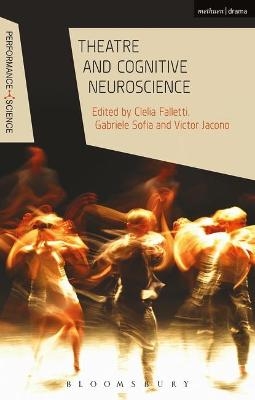
Theatre and Cognitive Neuroscience
Methuen Drama (Verlag)
978-1-350-03559-1 (ISBN)
* Theatre as a space of relationships: a neurocognitive perspective
* The spectator’s performative experience and ‘embodied theatrology’
* The complexity of theatre and human cognition
* Interdisciplinary perspectives on applied performance
Each part includes contributions from international pioneers of interdisciplinarity in theatre scholarship, and from neuroscientists of world-renown researching the physiology of action, the mirror neuron mechanism, action perception, space perception, empathy and intersubjectivity.
While illustrating the remarkable growth of interest in the performing arts for cognitive neuroscience, this volume also reveals the extraordinary richness of exchange and debate born out of different approaches to the topics.
Clelia Falletti is Associate Professor at Sapienza University of Rome, Italy. Since 1981 she has participated in research by ISTA (International School of Theatre Anthropology) directed by Eugenio Barba; she is dramaturg for Teatro Potlach, and co-editor of theatre books series with two Italian publishing houses. Gabriele Sofia teaches theatre studies and physical theatre at Paul Valéry University, Montpellier, France. Since 2006 he has carried out an interdisciplinary research project on the neurophysiology of the actor and the spectator between the Sapienza University of Rome and the Maisons des Sciences de l’Homme Paris Nord. From 2009 to 2013 he promoted and organized five editions of the International Conference “Dialogues between Theatre and Neuroscience” at Sapienza. Victor Jacono, PhD in Performance Studies, teaches at the MCAST Institute for the Creative Arts and Drama at the Alternative Learning Program, Malta.
Preface
Part One: Theatre as a space of relationships: a neurocognitive approach
1. Editorial Introduction: The space of shared action (Clelia Falletti, Sapienza University of Rome, Italy)
2. “Mirror mechanism” and motor behavior (Maria Alessandra Umiltà, neuroscientist, University of Parma, Italy)
3. Body presence and extra-personal space perception (Giorgia Committeri and Chiara Fini neuroscientists, University of Chieti, Italy)
4. The actor at the circus. Towards a cognitive approach (Philippe Goudard, University Paul Valéry Montpellier 3, France)
Part Two: The spectator’s performative experience and “Embodied theatrology”
5. Editorial introduction: Towards an “Embodied Theatrology”? (Gabriele Sofia, University Paul Valéry Montpellier 3, France)
6. Body and corporeality. A small multidisciplinary glossary (Marco De Marinis, University of Bologna, Italy)
7. Audiences’ experience of proximity and co-presence in live dance performance (Corinne Jola, neuroscientist and choreographer, Abertay University, Dundee and Matthew Reason, Faculty of Arts, York St John University, UK)
8. “Theatre and science”. Some reflections on the theatre effectiveness mechanism in Antonin Artaud (Lorraine Dumenil, University Paris 3 Sorbonne Nouvelle, France)
Part Three: The complexity of theatre and human cognition
9. Editorial Introduction: The Complexity of the actor’s pedagogy and human cognition (Victor Jacono, Sapienza University of Rome, Italy)
10. A rope over an abyss (John J. Schranz, University of Malta)
11. The actor’s embodied language. Preliminary indications from a pilot experiment (Gabriele Sofia; Silvia Spadacenta, neuroscientist, University of Tu¨bingen, Germany; Clelia Falletti; Giovanni Mirabella, neuroscientist, Sapienza University of Rome, Italy)
12. Perception and the organization of time in the theatre (Luciano Mariti, Sapienza University of Rome, Italy)
Part Four: Interdisciplinary perspectives in applied performance
13. Editorial introduction: Does art therapy work as a rehabilitative tool? (Giovanni Mirabella neuroscientist, Sapienza University of Rome, Italy)
14. Use of theatrical techniques and elements as interventions for autism spectrum disorders (Jenna Gabriel, Harvard University, USA; Elisa Angevin, Columbia University, USA; Tamara Rosen and Matthew D. Lerner, Stony Brook University, USA)
15. Theatre is a valuable tool for parkinson’s disease rehabilitation (Nicola Modugno, neurologist, IRCCS, Neuromed, Pozzilli; Imogen Kusch, theatre director of the Klesidra Company, Rome and Giovanni Mirabella)
16. Theatre and therapy: care, cure or illusion? (Jean-Marie Pradier, Ethnoscenologist, University Paris 8 – MSH-Paris Nord, France)
Afterword
Endnotes
Index
| Erscheinungsdatum | 20.10.2017 |
|---|---|
| Reihe/Serie | Performance and Science: Interdisciplinary Dialogues |
| Verlagsort | London |
| Sprache | englisch |
| Maße | 138 x 216 mm |
| Gewicht | 331 g |
| Themenwelt | Kunst / Musik / Theater ► Film / TV |
| Kunst / Musik / Theater ► Theater / Ballett | |
| Medizin / Pharmazie ► Medizinische Fachgebiete ► Neurologie | |
| Medizin / Pharmazie ► Studium ► 1. Studienabschnitt (Vorklinik) | |
| Naturwissenschaften ► Biologie ► Humanbiologie | |
| Naturwissenschaften ► Biologie ► Zoologie | |
| Sozialwissenschaften | |
| ISBN-10 | 1-350-03559-9 / 1350035599 |
| ISBN-13 | 978-1-350-03559-1 / 9781350035591 |
| Zustand | Neuware |
| Informationen gemäß Produktsicherheitsverordnung (GPSR) | |
| Haben Sie eine Frage zum Produkt? |
aus dem Bereich


